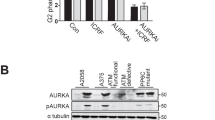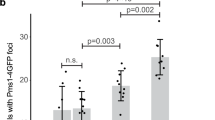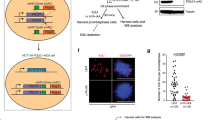Abstract
Defective S-phase checkpoint activation results in an inability to downregulate DNA replication following genotoxic insult such as exposure to ionizing radiation. This 'radioresistant DNA synthesis' (RDS) is a phenotypic hallmark of ataxia–telangiectasia1, a cancer-prone disorder caused by mutations in ATM2. The mismatch repair system principally corrects nucleotide mismatches that arise during replication3. Here we show that the mismatch repair system is required for activation of the S-phase checkpoint in response to ionizing radiation. Cells deficient in mismatch repair proteins showed RDS, and restoration of mismatch repair function restored normal S-phase checkpoint function. Catalytic activation of ATM and ATM-mediated phosphorylation of the protein NBS1 (also called nibrin) occurred independently of mismatch repair. However, ATM-dependent phosphorylation and activation of the checkpoint kinase CHK2 and subsequent degradation of its downstream target, CDC25A, was abrogated in cells lacking mismatch repair. In vitro and in vivo approaches both show that MSH2 binds to CHK2 and that MLH1 associates with ATM. These findings indicate that the mismatch repair complex formed at the sites of DNA damage facilitates the phosphorylation of CHK2 by ATM, and that defects in this mechanism form the molecular basis for the RDS observed in cells deficient in mismatch repair.
This is a preview of subscription content, access via your institution
Access options
Subscribe to this journal
Receive 12 print issues and online access
$209.00 per year
only $17.42 per issue
Buy this article
- Purchase on Springer Link
- Instant access to full article PDF
Prices may be subject to local taxes which are calculated during checkout





Similar content being viewed by others
References
Painter, R.B. Radioresistant DNA synthesis: an intrinsic feature of ataxia–telangiectasia. Mutat. Res. 84, 183–190 (1981).
Savitsky, K. et al. A single ataxia–telangiectasia gene with a product similar to PI-3 kinase. Science 268, 1749–1753 (1995).
Modrich, P. & Lahue, R. Mismatch repair in replication fidelity, genetic recombination, and cancer biology. Annu. Rev. Biochem. 65, 101–133 (1996).
Goldmacher, V.S., Cuzick, R.A. Jr. & Thilly, W.G. Isolation and partial characterization of human cell mutants differing in sensitivity to killing and mutation by methylnitrosourea and N-methyl-N′-nitro-N-nitrosoguanidine. J. Biol. Chem. 261, 12462–12471 (1986).
Kat, A. et al. An alkylation-tolerant, mutator human cell line is deficient in strand-specific mismatch repair. Proc. Natl. Acad. Sci. USA 90, 6424–6428 (1993).
Zhang, H. et al. Apoptosis induced by overexpression of hMSH2 or hMLH1. Cancer Res. 59, 3021–3027 (1999).
Yan, T. et al. Loss of DNA mismatch repair imparts defective cdc2 signaling and G2 arrest responses without altering survival after ionizing radiation. Cancer Res. 61, 8290–8297 (2001).
Veigl, M.L. et al. Biallelic inactivation of hMLH1 by epigenetic gene silencing, a novel mechanism causing human MSI cancers. Proc. Natl. Acad. Sci. USA 95, 8698–8702 (1998).
Lim, D.S. et al. ATM phosphorylates p95/nbs1 in an S-phase checkpoint pathway. Nature 404, 613–617 (2000).
Gatei, M. et al. ATM-dependent phosphorylation of nibrin in response to radiation exposure. Nat. Genet. 25, 115–119 (2000).
Zhao, S. et al. Functional link between ataxia–telangiectasia and Nijmegen breakage syndrome gene products. Nature 405, 473–477 (2000).
Falck, J., Mailand, N., Syljuasen, R.G., Bartek, J. & Lukas, J. The ATM–Chk2–CDC25A checkpoint pathway guards against radioresistant DNA synthesis. Nature 410, 842–847 (2001).
Falck, J., Petrini, J.H., Williams, B.R., Lukas, J. & Bartek, J. The DNA damage-dependent intra-S phase checkpoint is regulated by parallel pathways. Nat. Genet. 30, 290–294 (2002).
Jinno, S. et al. CDC25A is a novel phosphatase functioning early in the cell cycle. EMBO J. 13, 1549–1556 (1994).
Mailand, N. et al. Rapid destruction of human CDC25A in response to DNA damage. Science 288, 1425–1429 (2000).
Baskaran, R. et al. Ataxia–telangiectasia mutant protein activates c-Abl tyrosine kinase in response to ionizing radiation. Nature 387, 516–519 (1997).
Maser, R.S., Monsen, K.J., Nelms, B.E. & Petrini, J.H. hMre11 and hRad50 nuclear foci are induced during the normal cellular response to DNA double-strand breaks. Mol. Cell. Biol. 17, 6087–6096 (1997).
Matsuoka, S. et al. Ataxia–telangiectasia-mutated phosphorylates Chk2 in vivo and in vitro. Proc. Natl. Acad. Sci. USA 97, 10389–10394 (2000).
Shiloh, Y. Ataxia–telangiectasia and the Nijmegen breakage syndrome: related disorders but genes apart. Annu. Rev. Genet. 31, 635–662 (1997).
Fritzell, J.A. et al. Role of DNA mismatch repair in the cytotoxicity of ionizing radiation. Cancer Res. 57, 5143–5147 (1997).
Chen, S.K., Tsai, M.H., Hwang, J.J., Chang, W.P. & Chan, W.P. Determination of 8-oxoguanine in individual cell nucleus of γ-irradiated mammalian cells. Radiat. Res. 155, 832–836 (2001).
Ni, T.T., Marsischky, G.T. & Kolodner, R.D. MSH2 and MSH6 are required for removal of adenine misincorporated opposite 8-oxo-guanine in S. cerevisiae. Mol. Cell 4, 439–444 (1999).
Wang, Y. et al. BASC, a super complex of BRCA1-associated proteins involved in the recognition and repair of aberrant DNA structures. Genes Dev. 14, 927–939 (2000).
Giannini, G. et al. Human MRE11 is inactivated in mismatch repair–deficient cancers. EMBO Rep. 3, 248–254 (2002).
Koi, M. et al. Human chromosome 3 corrects mismatch repair deficiency and microsatellite instability and reduces N-methyl-N′-nitro-N-nitrosoguanidine tolerance in colon tumor cells with homozygous hMLH1 mutation. Cancer Res. 54, 4308–4312 (1994).
Umar, A. et al. Correction of hypermutability, N-methyl-N′-nitro-N-nitrosoguanidine resistance, and defective DNA mismatch repair by introducing chromosome 2 into human tumor cells with mutations in MSH2 and MSH6. Cancer Res. 57, 3949–3955 (1997).
Nehme, A. et al. Differential induction of c-Jun NH2-terminal kinase and c-Abl kinase in DNA mismatch repair-proficient and -deficient cells exposed to cisplatin. Cancer Res. 57, 3253–3257 (1997).
Buermeyer, A.B., Wilson-Van Patten, C., Baker, S.M. & Liskay, R.M. The human MLH1 cDNA complements DNA mismatch repair defects in Mlh1-deficient mouse embryonic fibroblasts. Cancer Res. 59, 538–541 (1999).
Brown, K.D. et al. The ataxia–telangiectasia gene product, a constitutively expressed nuclear protein that is not upregulated following genome damage. Proc. Natl. Acad. Sci. USA 94, 1840–1845 (1997).
Lee, C.H. & Chung, J.H. The hCds1 (Chk2)-FHA domain is essential for a chain of phosphorylation events on hCds1 that is induced by ionizing radiation. J. Biol. Chem. 276, 30537–30541 (2001).
Acknowledgements
The authors thank S. Elledge for supplying the GST–CHK2 plasmid, J. Lazo for the GST–CDC25A plasmid and B. Gebhardt for access to the 137Cs irradiator. This work was supported by grants from the American Cancer Society to K.D.B. and R.B. and the US National Institutes of Health to R.B.
Author information
Authors and Affiliations
Corresponding author
Ethics declarations
Competing interests
The authors declare no competing financial interests.
Rights and permissions
About this article
Cite this article
Brown, K., Rathi, A., Kamath, R. et al. The mismatch repair system is required for S-phase checkpoint activation. Nat Genet 33, 80–84 (2003). https://doi.org/10.1038/ng1052
Received:
Accepted:
Published:
Issue Date:
DOI: https://doi.org/10.1038/ng1052
This article is cited by
-
Pharmacological inhibition of ataxia-telangiectasia mutated exacerbates acute kidney injury by activating p53 signaling in mice
Scientific Reports (2020)
-
The capacity of oocytes for DNA repair
Cellular and Molecular Life Sciences (2018)
-
Deoxyinosine triphosphate induces MLH1/PMS2- and p53-dependent cell growth arrest and DNA instability in mammalian cells
Scientific Reports (2016)
-
Synchronous glioblastoma and medulloblastoma in a child with mismatch repair mutation
Child's Nervous System (2016)
-
TRIM29 regulates the assembly of DNA repair proteins into damaged chromatin
Nature Communications (2015)



